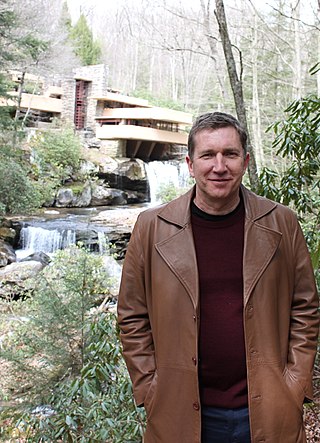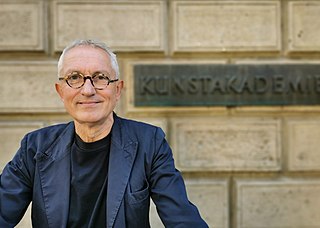
The Altes Museum is a listed building on the Museum Island in the historic centre of Berlin, Germany. Built between 1825 and 1830 by order of King Frederick William III of Prussia according to plans by Karl Friedrich Schinkel, it is considered a major work of German Neoclassical architecture. It is surrounded by the Berlin Cathedral to the east, the Berlin Palace to the south and the Zeughaus to the west. Currently, the Altes Museum houses the Antikensammlung and parts of the Münzkabinett. As part of the Museum Island complex, the Altes Museum was listed as a UNESCO World Heritage Site in 1999, in recognition of its testimony to the development of the museum as a social and architectural phenomenon.

Friedrich David Gilly was a German architect and the son of the architect David Gilly. His works are influenced by revolutionary architecture (Revolutionsarchitektur). Born in Altdamm, Pomerania,, Gilly was known as a prodigy and the teacher of the young Karl Friedrich Schinkel.

Berliner Fussball Club Dynamo e. V., commonly abbreviated to BFC Dynamo or BFC, alternatively sometimes called Dynamo Berlin, is a German football club based in the locality of Alt-Hohenschönhausen of the borough of Lichtenberg of Berlin.

Adolf Bruno Behne was a German critic, art historian, architectural writer, and artistic activist. He was one of the leaders of the Avant Garde in the Weimar Republic.

Karl Heinz is an Austrian architect. With two colleagues, as the firm Heinz & Mathoi & Streli, he built private homes in the alpine landscape of Tyrol, schools, offices and public buildings, among others.
Julius Posener was a German architectural historian, author and higher education teacher.

Friedrich August von Kaulbach was a German portraitist and historical painter.

Markus Breitschmid is an American architectural theoretician, architect, and the author of several books on contemporary architecture and philosophical aesthetics. His most highly regarded books are Der bauende Geist. Friedrich Nietzsche und die Architektur (2001), The Significance of the Idea, and Non-Referential Architecture. His writings have been translated into Chinese, English, French, German, Hindi, Italian, Japanese, Korean, Russian, and Spanish. Breitschmid has been invited to contribute to the Venice Biennale of Architecture, the Architecture Biennale of Chicago, the Salone Internationale del Mobile di Milano in Milan, and the Triennale of Architecture in Lisbon. His work has been exhibited at the Galerie d'Architecture in Paris and the Royal Institute of British Architects in London.

Hansjörg Göritz is a German-American architect, professor, author and designer associated with pure and minimalist architecture that emphasizes place, space, light and material. For his early works he was awarded one of the most prestigious architecture awards in Germany in 1996, the Development Award Baukunst to the Kunstpreis Berlin by the Academy of Arts, Berlin. In 2013 he was recognized as an Affiliated Fellow to the American Academy in Rome.
Wolfram Hoepfner is a German classicist, archaeologist, architectural historian, and Professor of Ancient Architectural History, at the Free University of Berlin.

Sep Ruf was a German architect and designer strongly associated with the Bauhaus group. He was one of the representatives of modern architecture in Germany after World War II. His elegant buildings received high credits in Germany and Europe and his German pavilion of the Expo 58 in Brussels, built together with Egon Eiermann, achieved worldwide recognition. He attended the Interbau 1957 in Berlin-Hansaviertel and was one of the three architects who had the top secret order to create the governmental buildings in the new capital city of the Federal Republic of Germany, Bonn. His best known building was the residence for the Federal Chancellor of the Federal Republic of Germany, built for Ludwig Erhard, the so-called Chancellor's Bungalow.

Carl Moritz was a German architect and real-estate entrepreneur. Based in Cologne, he built the Cologne Opera House of 1902, and various banks, theatres and churches in Germany. Some of his buildings were destroyed during the last two years of his life in World War II.

The Association of German Architects is an association of architects founded in 1903 in Germany. It publishes the bimonthly magazine der architekt. The BDA has over 5,000 members. In 1995, it founded the German Architecture Centre DAZ in Berlin.
Feministische Organisation von Planerinnen und Architektinnen is an organisation working to address gender issues in the built environment generally and among professionals active in this field.
Volker Giencke in Wolfsberg is an Austrian architect.

Meixner Schlüter Wendt Architekten is a German architecture firm based in Frankfurt. The company's projects have received awards the World Architecture Festival in 2008 and at the Venice Biennale of Architecture in 2004, 2006 and 2012.

Marc Kocher is a Swiss architect, known for his residential building designs.

Karl-Heinz Petzinka is a German architect, and Rector of the Kunstakademie Düsseldorf. He is known for office buildings in Düsseldorf and Berlin. He converted historic industrial buildings, and was responsible for the section architecture for the Ruhr.2010 project.
Christopher Roth is a German film director, artist and TV producer.














